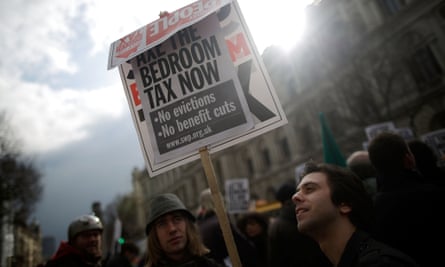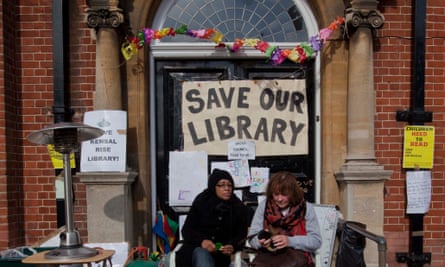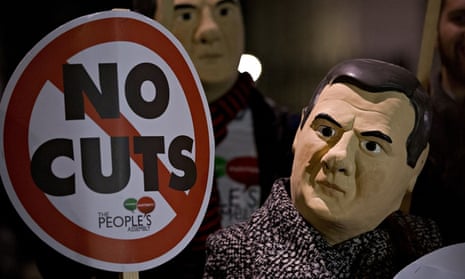George Osborne says the coverage of looming new spending cuts has been “hyperbolic”, but away from Downing Street there is a strong consensus that the cumulative effect of five years of austerity will make the next wave of cuts, in 2015, very painful.
Four more years of austerity is “a price that works for our country”, Osborne said as he outlined his strategy. The Institute for Fiscal Studies responded by warning that “colossal” cuts to the state would take total government spending to its lowest level as a proportion of national income since before the second world war. By the end of the process, “the role and shape of the state will have changed beyond recognition”, the think tank said. So far, £35bn has been cut; the plan is to cut a further £55bn by 2019.
If the chancellor remains in post after the general election, Britain will find itself halfway through a nine-year stretch of spending cuts, with the Conservatives determined to shrink and redefine the role of the state. The Liberal Democrats say the Conservative policy is aimed at creating “a smaller state, with many more cuts to come”, giving Britain “austerity for ever”; 2015 will be a pivotal year in the race to reshape the nature of the state. Even if they lose, difficult spending cuts look inevitable. Labour is also committed to ending the deficit, in 2017-18, provided the state of the economy allows it.

For many publicly funded services and organisations, 2015 will be the year when their chances of survival become clear. There is an enormous range in the size and the function of services under threat, which makes tracking the scale of the cuts challenging.
Here are just four examples – from the large scale to the tiny, of services that are set to go this year.
In June, the Independent Living Fund, which provides funding for around 18,000 disabled people to work and live in the community, will be wound down. In Liverpool, there will be a decision in early 2015 over whether the council will close a possible 23 out of the city’s 26 Sure Start centres. On a smaller scale, organisations including the Islington Centre for Refugees and Migrants, in north London, which supports around 150 refugees and asylum seekers, providing English classes, faces closure because of cuts to education budgets. “These are people who come to us on a daily basis who desperately need some kind of support,” project manager Andy Ruiz Palma says. “I would lose my job, but I am more worried about the clients. There is nowhere else for them to go.” In Ealing, west London, parents are campaigning to save the lollipop crossing role, done for the past 20 years by Eileen Rowles, and now at risk of being discontinued because of council spending cuts.
The Office for Budget Responsibility said in December that the chancellor’s plans would mean one million further government job losses by 2020 (a total fall from early 2011 of 1.3 million), representing a 20% fall in headcount.
Over the past five years, there has been surprise and relief from politicians that public anger about spending cuts has been relatively muted. Aside from a few annual anti-cuts marches in big cities, Britain has not experienced the waves of protest seen in countries such as Spain. Given that those most affected by the cuts are the most vulnerable and disempowered people in society, it’s perhaps not surprising that the response has been muted.
But that could change in 2015. The next stage of cutbacks is likely to be harder to ignore. The easy decisions have already been made; once the low-hanging fruit has been removed, finding new things to cut gets harder, which means the second half of the austerity era is likely to be much tougher than the first.
By next May, government funding for councils will be 40% lower than it was in 2010; and a further 13% will need to be cut in 2015. “It is individuals who have paid the price of funding reductions, whether it is through seeing their local library close, roads deteriorate or support for young people or families scaled back. Further reductions without radical reform will have a detrimental impact on people’s quality of life,” the Local Government Association chair, David Sparks, says.

The National Audit Office has warned that more than half of councils currently risk falling into serious financial crisis before the end of the decade. Some may struggle to provide services that they are legally obliged to offer, and this may become apparent in 2015 with more legal action by service users.
Nicola Smith, head of economic affairs at the TUC, says: “The scale of the spending cuts that the chancellor set out in his autumn statement briefing is truly severe. The public sector has already experienced five years of austerity. The consequences for key services that people rely on are severe.”
Osborne has said that if the Conservatives win the election he will want to cut a further £12bn a year from the welfare bill – on top of the £20m-£25m that has already been cut. He proposes freezing working-age benefits for two years, reducing the overall benefit cap from £26,000 to £23,000, and limiting access to housing benefit for people under 21.
Professor John Hills, director of the Centre for Analysis of Social Exclusion at the London School of Economics, says that the impact of further cuts in this area would be very painful. “Both the political and public belief is that spending on out-of-work benefits is a large share of overall public spending; it is not. Trying to make large savings from what is really a small share of public spending will require increasingly harsh cuts. We have seen this already through things like the bedroom tax, the imposition of council tax on people with very low incomes, and the greatly increased use of sanctioning. To continue to get more savings from that group will require harsher measures.”

Comments (…)
Sign in or create your Guardian account to join the discussion